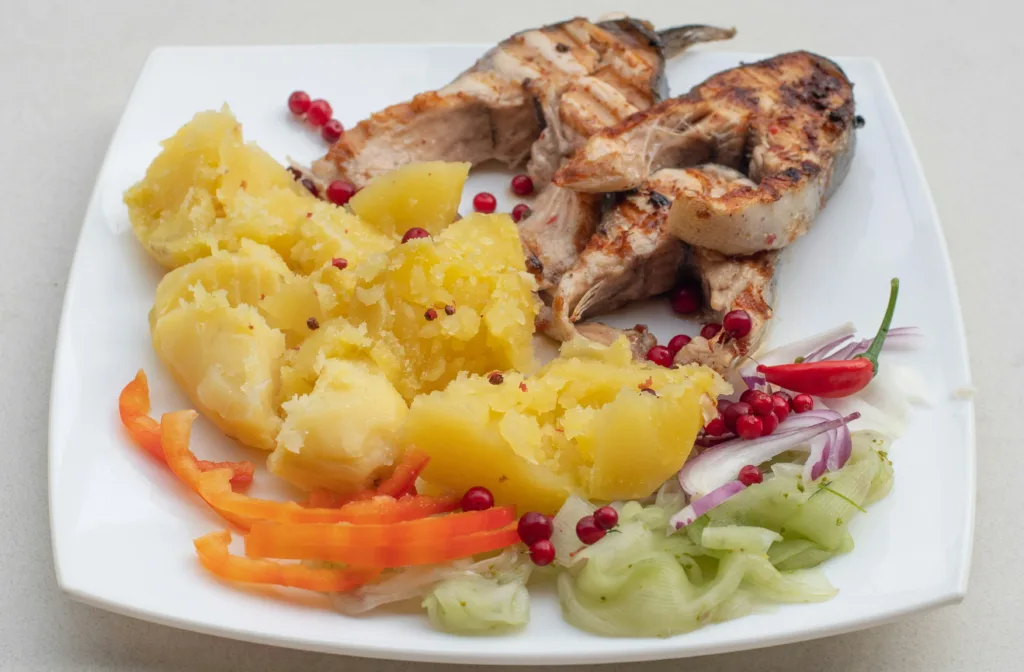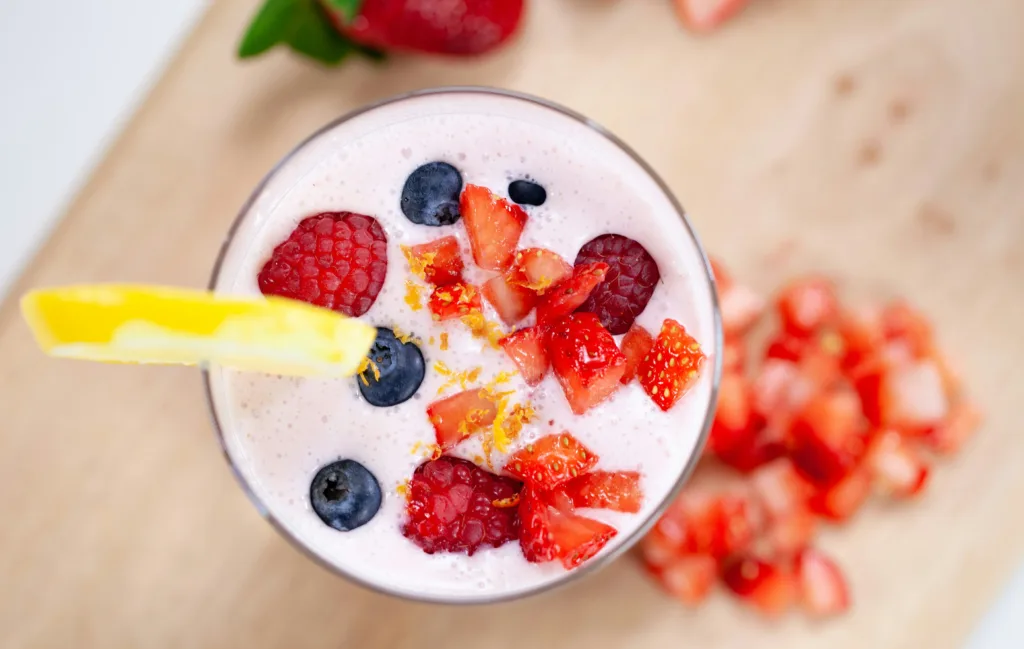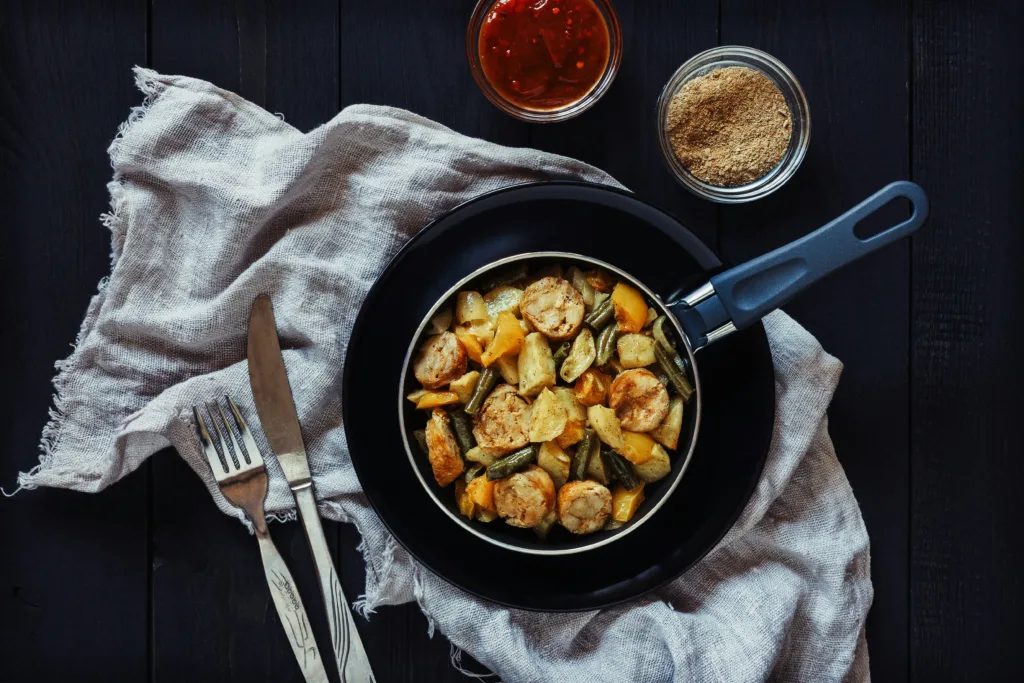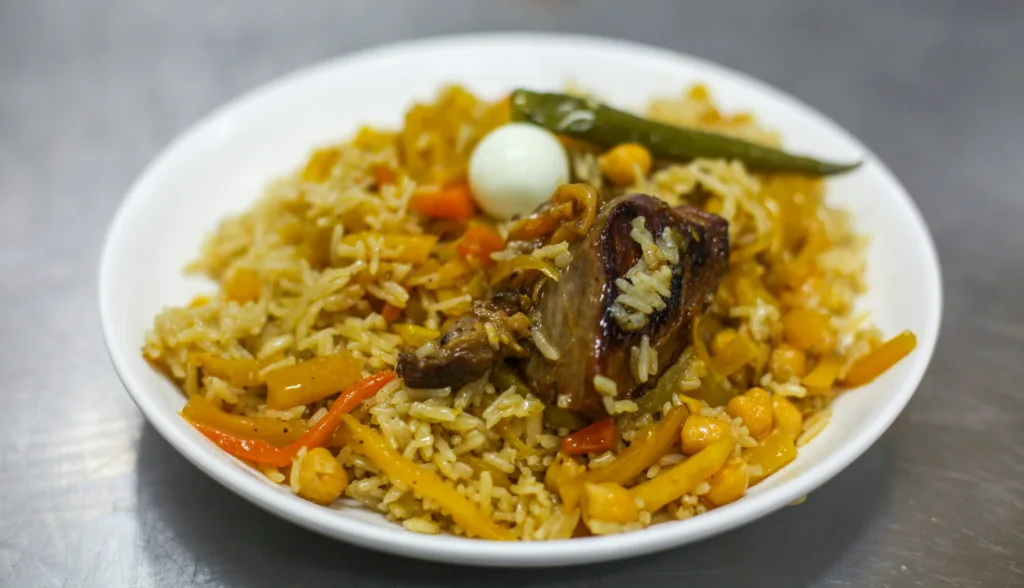Dealing with ulcerative colitis means eating with a little more thought. Some days your gut’s quiet, other days everything feels off. There’s no one-size-fits-all fix, but planning your meals around comfort, tolerance, and balance can help you stay a step ahead. This 7-day meal plan isn’t a strict diet, and it’s definitely not medical advice. It’s a framework built around foods that are usually easier on the gut, especially during flares or recovery periods.
We’re not here to tell you what you can or can’t eat. Only you and your healthcare team can decide that. What we’ve done is pull together a practical plan using gentle, low-fiber meals that are generally considered safer for people managing UC. No hard rules, no fancy ingredients, just ideas you can work with.
To make all of this a little more manageable, we built ReciMe. It’s an app that helps you stay on track with meals that suit your needs, especially when you’re working around a condition like ulcerative colitis. You can save recipes from Instagram, TikTok, Pinterest, YouTube, or even your Notes app, and organize them into cookbooks. From there, it’s easy to build a weekly plan and turn it into a grocery list that’s sorted by aisle or by recipe. You’ll also see basic nutrition info like calories, protein, and carbs, which can be useful if you’re tracking what fuels you best. ReciMe runs on iOS, Android, and as a Chrome Extension, so whether you’re planning at your desk or cooking in your kitchen, it all stays in one place. We made it to take the stress out of planning meals, especially when your gut doesn’t like surprises.


What Makes a Meal UC-Friendly?
There’s a lot of trial and error involved in figuring out what your gut will tolerate. In general, UC-friendly meals keep it simple and focus on ease of digestion, especially when symptoms are active. During a flare, that often means leaning on lower fiber, cooked foods with mild seasoning. When things are calmer, you might be able to reintroduce more variety slowly.
Here’s what usually helps during flare-ups or recovery:
- Well-cooked vegetables (instead of raw or crunchy)
- Soft carbs like white rice, potatoes, or white bread
- Lean proteins that are grilled, poached, or baked
- Lactose-free or low-lactose dairy (if tolerated)
- Mild herbs and spices without heat
- Plenty of fluids to stay hydrated
And what’s usually best to avoid:
- Raw cruciferous veggies like broccoli, cauliflower, or cabbage
- Nuts, seeds, and whole grains with rough textures
- Fatty or fried foods, including oily fish
- Spicy sauces and chili-based seasonings
- Alcohol and carbonated drinks
- Fermented foods during active flares (even if they’re helpful in remission)
Not everyone reacts the same way. You might tolerate something that bothers someone else. But this list can help you build a starting point, especially if you’re in symptom management mode.

Building Your Week: The Approach
The goal is variety without overwhelm. Every day includes breakfast, lunch, dinner, and a snack. The ingredients focus on balance, with easy prep options and wiggle room if you want to adjust. If you’re mid-flare, go lighter on fiber and lean into more bland, simple meals. If you’re in remission, feel free to explore a little more.
Day 1
Breakfast – Scrambled Eggs with White Toast and Banana Slices
A classic soft breakfast: scrambled eggs in olive oil with a slice of plain white toast and sliced banana on the side. Easy to digest and balanced.
Lunch – Turkey and Rice Soup
Lean ground turkey simmered in a mild broth with overcooked white rice and soft carrots. Skip the spices and keep it plain for a gentle lunch.
Dinner – Baked Cod with Mashed Potatoes And Zucchini
Mild white fish baked with a drizzle of olive oil, served with smooth mashed potatoes and soft, steamed zucchini. It’s filling but not heavy.
Snack – Applesauce and Rice Crackers
Plain, unsweetened applesauce paired with rice crackers gives you a mild snack that’s light and low in fiber.
Day 2
Breakfast – Cream of Rice With Banana
Warm cream of rice cooked with almond milk and topped with soft, thin banana slices. A little cinnamon for flavor if tolerated.
Lunch – Poached Chicken and Peeled Cucumber
Poached skinless chicken breast served with peeled, de-seeded cucumber slices and a bit of plain white bread. No sauces needed.
Dinner – Ground Turkey with White Rice and Carrots
Ground turkey cooked without seasoning, served with plain white rice and boiled carrots. Mild, soft, and easy on the gut.
Snack – Lactose-Free Yogurt with Canned Peaches
A few spoonfuls of lactose-free plain yogurt with soft, canned peaches in juice (not syrup). Smooth, slightly sweet, and gentle.
Day 3
Breakfast – Hard-Boiled Egg and White Toast
One or two hard-boiled eggs with a slice of white toast. Add a little salt if you want, but skip the butter if fat is a concern.
Lunch – Rice Porridge with Ground Chicken
A simple rice porridge (congee-style) made with ground chicken and a bit of broth. Add soft carrots or squash if tolerated.
Dinner – Baked Tilapia with Mashed Sweet Potato and Green Beans
Mild fish like tilapia baked plain, with mashed sweet potato and well-steamed green beans. Avoid skins or stringy bits.
Snack – Pear Puree
Steamed and blended pear (or store-bought unsweetened pear puree). A naturally sweet, gut-friendly snack.
Day 4
Breakfast – Oatmeal with Almond Milk and Peeled Apple
Plain oats cooked soft in almond milk, topped with peeled, cooked apple slices. Add a drizzle of maple syrup if needed for taste.
Lunch – Chicken and Potato Mash
Shredded chicken mixed into mashed white or yellow potatoes with a touch of olive oil. No spices, just soft and warm comfort.
Dinner – Tilapia with White Rice and Steamed Zucchini
Bake or poach tilapia and pair it with plain rice and soft zucchini slices. Mild, moist, and easy to digest.
Snack – Soft-Cooked Carrot Sticks
Boil carrots until soft and chill them for a gentle, naturally sweet snack with texture but no crunch.

Day 5
Breakfast – Rice Flakes Cereal with Lactose-Free Milk
A bowl of plain rice flake cereal softened in lactose-free milk. Add a few soft banana slices for sweetness.
Lunch – Turkey and Mashed Carrot Plate
Plain turkey breast sliced and served with mashed carrots and a spoonful of white rice. Mild and simple.
Dinner – Chicken Noodle Soup
Cooked with soft noodles, carrots, and skinless chicken breast in low-sodium broth. Keep the ingredients overcooked and very soft.
Snack – Low-Fat Cottage Cheese (if Tolerated)
A few spoonfuls of lactose-free or low-lactose cottage cheese. Soft and mild, it can be filling without being heavy.
Day 6
Breakfast – Smooth Oatmeal with Pear
Rolled oats cooked with almond milk, topped with peeled, steamed pear slices. Avoid adding anything crunchy or fibrous.
Lunch – Chicken Rice Bowl
Shredded chicken breast over white rice with soft, boiled squash or zucchini. Drizzle with olive oil if extra calories are needed.
Dinner – Mild Baked White Fish and Potato Puree
Bake white fish like cod or tilapia and serve with plain mashed potatoes. Add soft green beans or cooked carrots if tolerated.
Snack – Applesauce and Toast
Unsweetened applesauce with a small piece of soft white toast. Light but satisfying when you want something between meals.
Day 7
Breakfast – Cream of Wheat With Banana
Cooked cream of wheat made with almond milk, topped with soft banana slices. Warm and easy to digest.
Lunch – Turkey Potato Patties
Mashed potatoes mixed with finely ground turkey, formed into soft patties and pan-seared lightly in olive oil. Serve with peeled cucumber slices.
Dinner – Chicken with Mashed Root Vegetables
Shredded chicken served with mashed carrots and potatoes. Optionally add steamed zucchini if it’s well tolerated.
Snack – Melon Slices
Ripe cantaloupe or honeydew melon cut into soft chunks. No skins or seeds, just hydrating and gentle sweetness.

Small Tips That Actually Help
Let’s face it, meal planning isn’t always easy, especially when your gut is unpredictable. But these small habits can make a real difference:
- Cook in batches: Make double portions of meals you tolerate well. Freeze the extras for rough days.
- Keep a food log: It sounds tedious, but jotting down what you eat and how you feel after can help spot triggers faster.
- Avoid skipping meals: An empty stomach can sometimes worsen symptoms. Aim to eat regularly, even if portions are small.
- Choose comfort: On flare days, don’t force yourself to eat raw salads or fibrous grains. Stick to simple, soft meals that go down easy.
UC and Nutrition: Why It Matters
UC isn’t just a gut issue. Over time, flares can mess with how well your body absorbs nutrients. That means your body might not be getting enough of what it needs even if you’re eating plenty. Common deficiencies include:
- Iron
- Vitamin B12
- Folate
- Vitamin D
- Calcium
If you’re experiencing fatigue, brain fog, or slow recovery, it might be worth getting blood work done and checking in with a dietitian. Supplementing when needed is sometimes essential.

What to Watch Out For
Even though there’s no strict “do not eat” list for ulcerative colitis, some foods are more likely to cause discomfort or worsen symptoms for a lot of people. If you’re in the middle of a flare or trying to prevent one, it’s worth paying closer attention to how these foods affect you:
- Raw broccoli, cauliflower, and Brussels sprouts
- Whole corn or popcorn
- Beans and lentils (especially during flare-ups)
- Nuts and seeds (including in butters or granola)
- Spicy seasonings and hot sauces
- Large amounts of dairy (for those who are lactose sensitive)
- Fatty cuts of red meat
- Fried or greasy fast food
- Sugar alcohols and artificial sweeteners
- Carbonated drinks
- Alcohol
You don’t have to cut everything out at once, but it helps to remove one or two things at a time and pay attention to how your gut responds. Keeping a simple food log can make patterns easier to catch.
Conclusion
Ulcerative colitis has a way of making food feel complicated, even when you’re doing your best to stay on track. That’s why building a meal plan that actually works for your body and your life can be a helpful step. This 7-day plan isn’t a perfect fix, and it’s definitely not set in stone, but it’s a practical starting point to help reduce decision fatigue and avoid food-related flare-ups.
The real goal here isn’t restriction. It’s awareness. Knowing what your body handles well, having some go-to meals that feel safe, and taking the guesswork out of your week can make a huge difference. If you’re still unsure about certain foods or symptoms, it’s always a good idea to loop in a dietitian. But in the meantime, starting small and being consistent goes a long way.
FAQ
Can I follow this meal plan during a flare-up?
Not exactly as is. This plan is more geared toward periods of remission when your digestive system is a little more stable. If you’re in the middle of a flare, you might need to adjust portions, skip fibrous ingredients, and stick with blander, low-residue foods until things settle down.
Do I have to avoid fiber completely?
No, but timing matters. During a flare, too much insoluble fiber (like raw veggies or whole grains) can make things worse. Once you’re feeling better, you can usually start easing it back in with cooked vegetables and soft fruits.
Is this a weight loss plan too?
It’s not designed for weight loss. This plan focuses on gut comfort, inflammation support, and steady nutrition. If you have goals around weight, energy, or nutrient intake, it’s best to work with a dietitian who can tailor your meals more specifically.
Can I use this plan if I’m vegetarian or gluten-free?
Absolutely, but you’ll want to make some swaps. For example, tofu or lentils can replace meat, and gluten-free grains like rice or certified oats can easily sub in where needed. The structure stays the same, but you make it yours.
What if I don’t have time to cook all of this?
You definitely don’t have to prep every single meal from scratch. Leftovers are your friend, and batch cooking a few things like rice, soup, or roasted veggies can save time. Tools like ReciMe also help organize your meals and grocery lists so you’re not starting from zero each day.
Why do some healthy foods still bother me?
Everyone with UC has a slightly different set of tolerances. What works for one person might feel terrible for another. That’s why tracking your symptoms and testing things gradually can help you figure out your own patterns over time.
Should I stick to this plan every week?
Not at all. It’s just a base. The goal isn’t to eat the same seven days over and over. It’s to give you a foundation you can build on, tweak, and rotate as your needs and appetite change.
